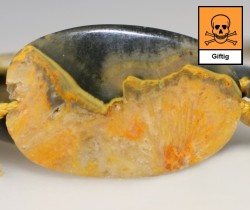Chapter: Antimony | Arsen | Lead| Cadmium | Chrome | Copper | Nickel | Mercury
Minerals are inorganic chemical compounds that crystallize naturally. Many of these compounds can also be produced industrially. The sale of these industrial products is subject to the Chemicals Levy Ordinance, which stipulates, among other things, that toxic substances must be labeled and may only be sold with a safety data sheet.
In the mineral trade, a corresponding procedure has been unusual up to now, because minerals are usually in a different form than industrial chemicals. Depending on whether they occur as powdery coatings, well crystallized, or as inclusions in host minerals, they develop varying degrees of toxicity. Substances used in the chemical industry are usually powdered, which gives them a significantly larger surface area than their crystallized mineral kingdom counterparts. A larger surface area means a larger surface area for solvents to attack and thus a greater potential to be absorbed by the human body.
One gram of a well-crystallized mineral can potentially pass through the gastrointestinal tract without being dissolved and causing symptoms of poisoning, whereas one gram of mineral powder can potentially be toxic. On the other hand, natural minerals are rarely as pure as the industrial products. Incorporated impurities or decay products can both improve solubility and add up to the potential hazards of the individual chemical compounds present.
In order to estimate the potential hazard posed by a toxic or harmful mineral, the following factors must be considered:







